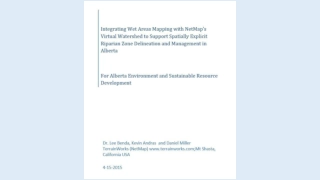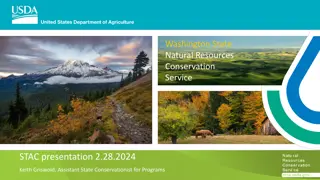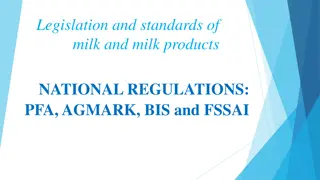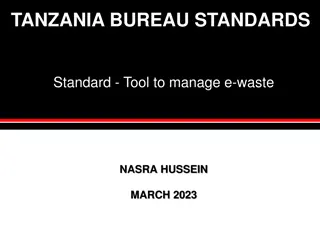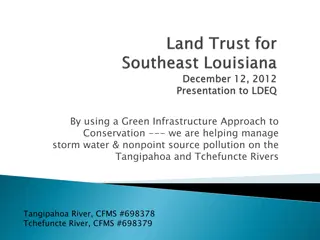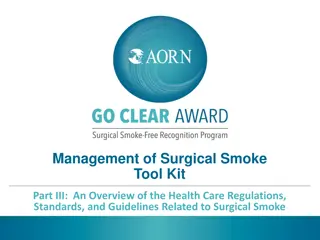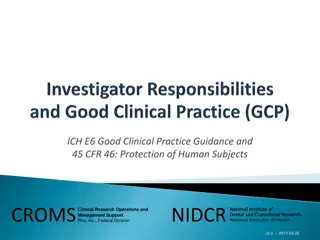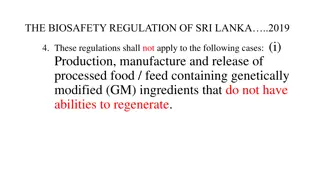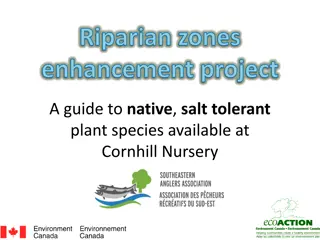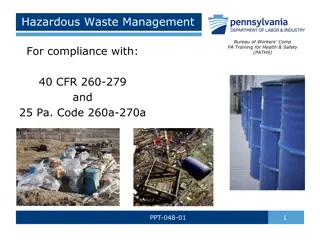Riparian Area Management Regulations and Standards Overview
Riparian area management has evolved over the years with regulations addressing timber harvest impacts on fish habitat and water quality. Key aspects include protection standards, considerations of economic feasibility, and the importance of preserving fish habitat for sustainable ecosystem health. Various regulations and standards have been updated to ensure the adequate preservation of riparian areas and their associated benefits.
Download Presentation

Please find below an Image/Link to download the presentation.
The content on the website is provided AS IS for your information and personal use only. It may not be sold, licensed, or shared on other websites without obtaining consent from the author. Download presentation by click this link. If you encounter any issues during the download, it is possible that the publisher has removed the file from their server.
E N D
Presentation Transcript
Background, history, and intent Types of riparian standards Riparian areas by landowner Allowed uses in riparian areas Other riparian area BMPs Variations from riparian standards
1990 - Riparian management first addressed in FRPA revision focused on Region I 1993 regulations variations, small streams, slope stability standards 2003 FRPA Region III riparian standards were revised with new waterbody classification system and riparian management standards 2004 Region II regulations updated
Protect riparian areas from the significant adverse effects of timber harvest activities on fish habitat and water quality. Take into account the economic feasibility of timber operations Adequate preservation of fish habitat. AS 41.17.115(a), 11 AAC 95.185(a)
short- and long-term source of large woody debris stream bank stability channel morphology water temperatures stream flows water quality adequate nutrient cycling food sources clean spawning gravels sunlight AS 41.17.115(a)
On private land: protection standards in AS 41.17.116(c) On state and other public land: from the shore or bank of an anadromous or high value resident fish water body (AS 41.17.118(a)(3) On private land: the areas subject to riparian On state and other public land: the area 100 AS 41.17.950 (23)(A),(C)
The distance measured must be horizontal distance rather than slope distance; Riparian areas are measured from the OHWM The distance from a tidal zone is measured from the line of mean higher high water mark. 11 AAC 95.280, .810 66 horizontal 66 horizontal
A non-glacial high value resident fish water body >3 feet wide at the OHWM; A non-glacial anadromous water body; or A backwater slough. AS 41.17.950 (39) Type III-A water: Birch Creek
A glacial high value resident fish water body or a glacial anadromous water body; Type III-B water bodies do not include glacial backwater sloughs AS 41.17.950 (40) Type III-B water: Tanana R.
A non-glacial high value resident fish water body that is < <3 OHWM and that does not contain anadromous fish. AS 41.17.950 (38) 3 wide at the Typically these are the lower reaches of small streams in close proximity to III-A streams; many are unnamed Keystone Creek
DPO information No-cut buffer Special management zone Maintain important fish and wildlife habitat Other riparian BMPs
DPOs must include: The location and classification of known surface waters adjacent to or within harvest units Any request for variation from riparian standards 11 AAC 95.220(5)(A),(14),.235
. No timber harvest of timber within 66 of the water body AS 41.17.116 (c)(1)
No timber harvest within 33 of the water body; Between 33 and 66 from the water body, up to 50% of standing white spruce trees > >9 requiring a variation; AS 41.17.116 (c)(2) 9 DBH may be harvested without
Harvest of timber within 100 of the water body must be located and designed primarily to protect fish habitat and surface water quality as determined by DNR with due deference to ADF&G. AS 41.17.116 (c)(3)
. No timber harvest within 100 of the water body; However, between 66 and 100 from the water body, harvest of timber may be undertaken where consistent with the maintenance of important fish and wildlife habitat as determined by DNR with the concurrence of ADF&G AS 41.17.118 (a)(3)(A), .119(3)
No timber harvest within 50 of the water body; Between 50 and 100 from the water body, up to 50% of standing white spruce trees > >9 requiring a variation; 9 DBH may be harvested without AS 41.17.118 (a)(3)(B), .119(3)
Harvest of timber within 100 of the water body must be consistent with the maintenance of important fish and wildlife habitat as determined by DNR with due deference to ADF&G AS 41.17.118 (a)(3)(B), .119(3)
DNR area and management plans (adopted under AS 38.04.065) may impose additional riparian protection standards for timber harvest operations On legislatively designated State Forests, riparian standards adopted by DNR may not exceed the FRPA standards unless the commissioner makes a finding of compelling state interest. AS 41.17.118(b) E. Tanana AP Upper Yukon AP Kuskokwim AP Yukon-Tanana AP Northwest AP Bristol Bay AP Tanana Valley SFMP Eastern Tanana AP
REGION III Riparian management on PRIVATE LAND Stream Type 100 150 200 250 300 33 50 66 Buffer Buffer III-A * * Buffer III-B Buffer Buffer Buffer *harvest allowed of up to 50% of white spruce >9 dbh * *Buffer Buffer III-C *harvest must be designed to protect fish habitat and water quality
REGION III Riparian management on STATE and OTHER PUBLIC LAND 100 150 200 250 300 Stream Type 33 50 66 * * buffer IIIA * *harvest allowed where consistent with maintenance of important fish and wildlife habitat * * *harvest allowed of up to 50% of white spruce >9 dbh * * *harvest must be consistent with maintenance of important fish and wildlife habitat IIIB buffer buffer IIIC
DPOs must include: An operator shall promptly inform DOF if a previously unknown fish water body is found within an operating area. Operations in the vicinity of a newly discovered or reclassified water body that has standing timber remaining in the riparian area must comply with the riparian standards with respect to the remaining timber. 11 AAC 95.220(5)(A),(14),.235. 265(e)
Operations allowed within riparian areas must be identified in the DPO Exception: felling and removing hazard trees along roadways as required by state or federal law is allowed and does not need to be in a DPO. 11 AAC 95.275(a),(b),(c)
Road building and associated activities where access is needed to a water body crossing, or where there is no feasible alternative. A stream crossing or a road in any riparian area must be designed and located to minimize significant adverse effects on fish habitat and on water quality. 11 AAC 95.275(a)(1), .285(b) A water body crossing built in accordance with the bridge standards. 11 AAC 95.275(a)(2),.300
Locating material extraction sites in braided, glacial floodplains in accordance with the regulations for material extraction and disposal sites (11 AAC 95.325); sites must be identified in a DPO. Installing blocks, or similar devices on a tree required for retention under this chapter if the device is installed to minimize damage to the tree. 11 AAC 95.275(a)(4),(5)
The use, as lift trees or tail holds, of trees required for retention under this chapter Hanging of rigging through the riparian area if necessary to be consistent with operator safety requirements and to have a clear line of sight and working area for the rigging On state and other public land, yarding corridors and other logging methods that do not cause a significant adverse impact to the riparian habitat 11 AAC 95.275(a)(6)-(8)
Note: There are additional BMPs in the following sections. This presentation includes only those subsections specific to riparian areas.
If feasible, an operator may not fell a tree into a riparian timber retention area. See also the purple book section on 11 AAC 95.355(e)(1) for compliance monitoring procedures 11AAC 95.355(e)
Where a riparian timber retention area abuts or is within a harvest unit, mark the limits of the riparian retention area before harvest begins. Each marking must be visible from adjacent markings; Marking with flagging, painting, or another identification system. 11AAC95.270 (a),(b)
Mark while the area is free of snow cover that would prevent accuracy, unless a water body is large, incised, or otherwise identifiable when under snow cover. A tree on a riparian retention area boundary is in the retention area if > >50% of the diameter of the bole of the tree is in the riparian retention area as measured at 4-1/2 feet above the ground or at the top of the root collar, whichever is higher. 11AAC95.270 (c),(d)
Any discharge of explosives in riparian areas in Region III requires a variation. 11 AAC 95.235, .335(a)(2)
In a riparian area, where feasible and necessary, leave high stumps to prevent felled and bucked timber from entering surface waters. See also the purple book section on 11 AAC 95.350(c) for objectives and compliance monitoring procedures 11 AAC 95.350(c)
When yarding in or near a riparian area, an operator shall make an effort to minimize soil disturbance and to prevent logs from rolling into surface waters or the riparian area. See also the purple book section on 11 AAC 95.360(c)(4) for objectives and compliance monitoring procedures 11 AAC 95.360(c)(4)
Partially or fully suspend logs when yarding. Select landings to minimize side-hill yarding near the stream or riparian area (e.g., position landings so logs are yarded uphill and away from the stream as much as possible). Do not locate landings near an incised stream, especially when yarding downhill. A high lead system has limited suspension capabilities. See also the purple book section on 11 AAC 95.360(c)(4) for objectives and compliance monitoring procedures
In riparian areas: Minimize the number of skidding routes Consistent with good safety practices, log skidding must minimize damage to retained trees, stumps, root systems, understory vegetation, and soils; and Use one-end suspension of logs. 11 AAC 95.365(b)
Shovel yarding rarely requires a skid trail in the riparian area. Where feasible, position the shovel outside the riparian area and reach into the area to remove the log. Fell and buck trees within a riparian area so any log segment is reachable from outside the riparian area An operator should be able to lift logs and swing them out of the riparian area with a very little disturbance. On very wet sites, conduct yarding when the ground is frozen. Purple book section re 11 AAC 95.365(b)
When slash is disposed of by burning, protect a riparian area from fire, and burn under weather conditions that minimize the chance of air quality degradation and fire escape. 11 AAC 95.370(b)
A forest landowner, timber owner, or operator may propose a variation to allow harvesting of specific trees within a riparian area. DOF shall agree to the proposed variation if it determines that the harm intended to be avoided by the requirement is not likely to occur because of site-specific circumstances, and is not likely to cause significant harm to fish habitat or water quality AS 41.17.087
If DOF does not agree to the proposed variation, the owner or operator may appeal to the DNR commissioner. Appellants must conform to the requirement while the appeal is pending. DNR shall give due deference to ADF&G and DEC for variation determinations AS 41.17.087
DOF will consider the impact of the variation harvest on non-merchantable trees within the riparian retention area, and may condition and document a variation authorization to protect non-merchantable trees that are important to maintain fish habitat and water quality. 11 AAC 95.235(d)
Include the following information in DPO: A map at 1:12,000 scale or finer that clearly shows the water body and the approximate location of the requested trees; The length of reach along which the variation trees are requested; The water body classification and average channel width of the reach along which the variation trees are requested; A description of the species and the DBH range of the trees requested for harvesting; 11 AAC 95.220(14)(B)
The minimum distance from OHWM to the proposed variation harvest; and The percentage of trees > >9 DBH within the reach for which any variation is sought that the operator is requesting to harvest, and that were harvested under a prior variation request, if any. 11 AAC 95.220(14)(B)


